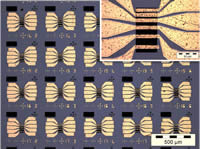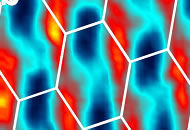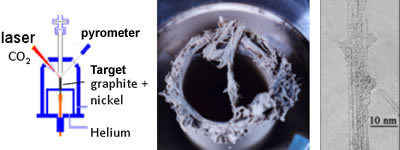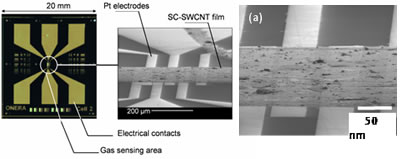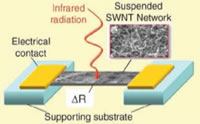Our nanotubes are right on track
Carbon nanotubes, long extremely thin tubes discovered twenty years ago, are very promising for the elaboration of new sensors highly sensitive to pollutants and explosives.
Number 49 - [Onera's Sanaa project]
|
|
ONERA hasn’t missed the boat when it comes to nanotechnology: since 1998, it has taken a close interest in nanoscience, which concerns objects of a few nanometres in size, that is, billionths of a meter. The first general nanoscience research programme, bringing together several ONERA teams, was implemented and then deployed in three successive programmes, the latest of which is called Sanaa. “Before developing nanotechnology applications, we had to gain knowledge and know-how on these objects”, says Brigitte Attal-Trétout, research director at ONERA. “The need to understand the physics of nano-objects, as well as to learn how to handle them is the key of that research. So we had to bring together skills in materials physics, solid state physics, sensors, plasma physics, etc.” |
|
The research has basically dealt with carbon nanotubes, long tubes composed only by carbon, 30,000 times finer than hair. ONERA first of all developed original synthesis reactor that has provided researchers very high quality carbon nanotubes. It thus allows the very first study the tubes structure, which depends greatly on their properties, particularly their electronic characteristics. Lastly, they looked at their mechanical and optics properties.
|
|
| “By studying the structure of the nanotubes under the electronic microscope, by analysing the temperature and the nature of the chemical species in situ at each stage of the process, and by developing numerical simulation tools, we have been able to understand how our nanotubes were formed”, says Annick Loiseau, research director at ONERA. It is a little like knitting a sock: the metallic catalyser plays the part of the knitting needles, gathering the carbon atomsin order to organize them and form the nanotube. The carbon enters in disorder and emerges ordered.” These studies on the formation of nanotubes are being pursued today: while how to start “knitting” is known, exactly how the nanotube is formed is still not understood; in other words, how the knitter chooses the type of stitch. However, this is a crucial question because the type of stitch determines the properties. The nanotube synthesis method developed by ONERA has been shown to be very versatile. “We have succeeded in synthesising the first single-wall nanotubes with chemical elements other than carbon, in particular nitrogen and boron (boron nitride) in 2001, as well as nitrogen-doped single-wall tubes”, recalls Annick Loiseau. | 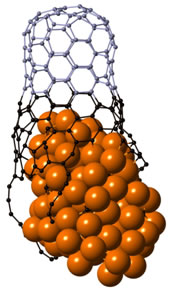 Numerical simulation of the growth of a nanotube3 |
| “We were then able to provide many laboratories with boron nitride nanotubes, in particular NASA. Boron nitride nanotubes have properties that are very different from those of carbon nanotubes: they are insulators, while carbon nanotubes are conductors or semi-conductors. These nanotubes have the particularity of being able to detect and emit radiation in the far UV. We have studied these properties on specific measurement benches that we had to design and develop first.” | |
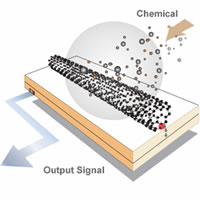 Principle of pollutant detection with nanotubes 4 |
Once in-depth knowledge on the synthesis and properties was obtained, ONERA was able to address nanotube-based applications, especially in the field of sensors and detectors. Aeronautics has, for example, an increasing need to measure molecules in low quantities, for environmental applications (pollutant detection) and safety applications (explosive detection). Nanotubes are very sensitive to their environment and their electronic properties change when they absorb molecules. We can use this sensitivity to detect very small amounts of gas, up to one molecule among a billion others, by simply measuring the change in conductivity of the nanotubes. “We have manufactured detectors for two model molecules, nitrogen dioxide (NO2) and ammonia (NH3), and they both proved to be competitive”, emphasizes Brigitte Attal-Trétout. “We took particular care with the measurement protocol, in order to obtain reliable and reproducible results, since nanotubes are highly extremely sensitive to some gas, the method has to provides evident proof of what is being detected.” That study is handled by Olivier Le Traon, ONERA's team expert in micro-sensors. |
|
« Nous avons fabriqué des détecteurs pour deux molécules modèles, le dioxyde d’azote (NO2) et l’ammoniac (NH3), ils se sont tous deux révélés compétitifs, souligne Brigitte Attal-Trétout. Nous avons particulièrement soigné le protocole de mesure, afin d’être certains que les résultats étaient fiables et reproductibles, car les nanotubes sont extrêmement sensibles à tous les gaz, et il faut être certain de ce qu’on détecte. »
Advantage of these detectors: the change in conductivity is simple to measure, while current optical detectors require lasers which are costly and cumbersome. “We are aiming for miniature systems, with low energy consumption and low cost, which may be easily integrated into structures, for example an airport room, a pipeline, a concrete slab or an aircraft wing", explains Brigitte Attal-Trétout. “If we achieve this, it will be an important breakthrough.”
Un projet de recherche a été déposé auprès de l’Agence nationale de recherche (ANR) en partenariat avec Thalès, afin de développer des capteurs d’humidité, très utiles pour étudier les traînées de condensation en aéronautique.
Another field of application explored by ONERA is infrared detection (IR). Here again, the nanotube's electrical conductivity is measured: the exposure of nanotube films to infrared light radiation induces a change in temperature and conductivity. A team from ONERA’s Optics Department (DOTA), under the responsibility of Ryad Haidar, is developing sensors which have the advantage of functioning at room temperature. |
|
 High-resolution electronic microscope image of a sheet of graphene 7 |
ONERA researchers are also interested in similar applications using graphene, a single layer structure only composed of carbon, from which advantages related to the 2D structure are expected. New thesis works are being launched of these topics. |
|
Notes : |
|
